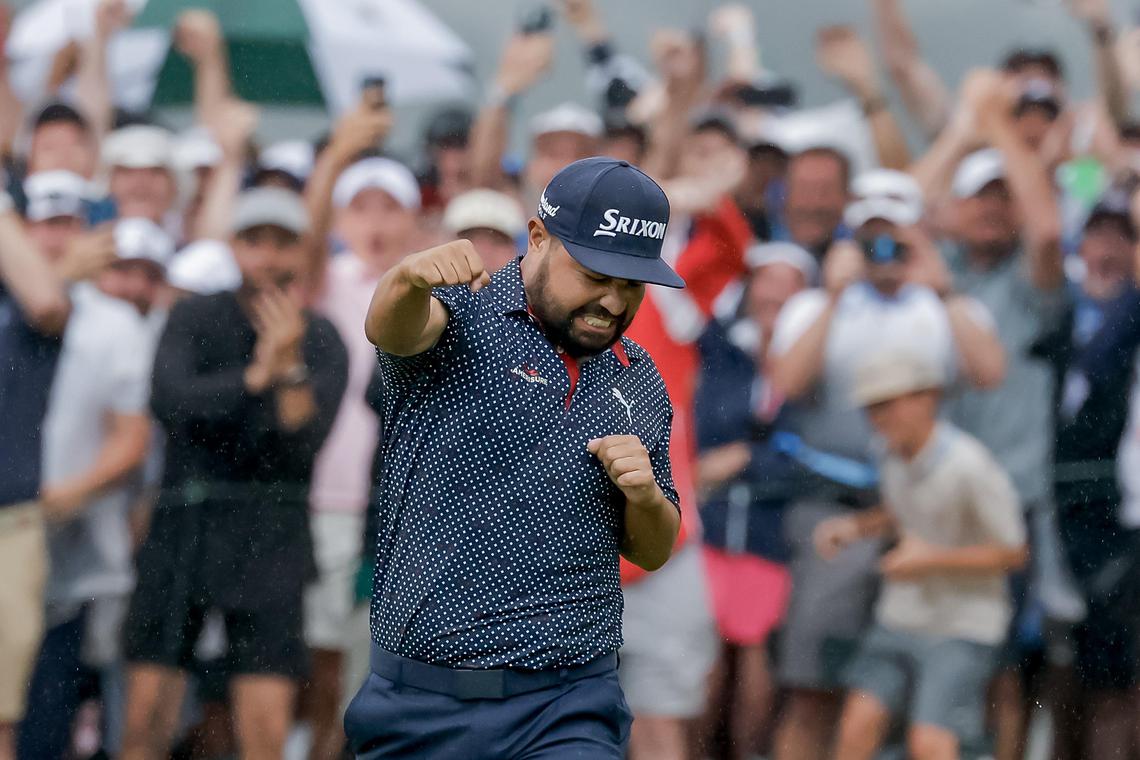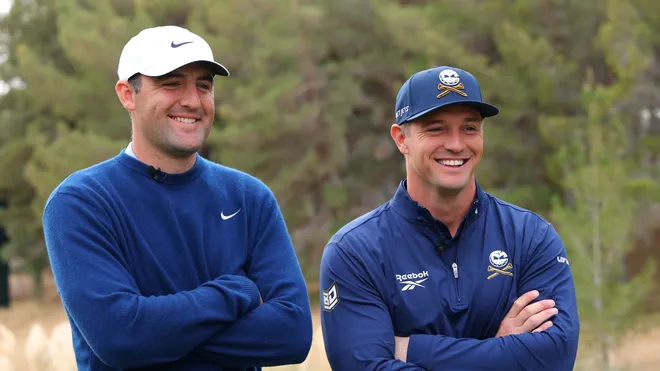PGA News
7 Things We Learned from Leaked PGA Tour-Saudi PIF Agreement


PGA Tour holds marathon 5-hour player meeting over PIF-Saudi deal. It’s hard to top the shock value of the merger itself, but here are 7 other MOST astonishing revelations from the deal. Honestly, it’s still quite unclear how, or even IF it will all go down. As of right now…Here’s what we know.
Twenty days after the shocking announcement of a “framework agreement” between the PGA Tour and the Saudi Arabian Public Investment Fund, confidential copies of the deal became public Monday night. The document, which was first reported on by The Athletic and No Laying Up and also obtained by GOLF.com, was sent to Congress Monday evening, ahead of the July 11 Senate hearing on the proposed partnership.
According to the five-page accord, which was signed May 30, the proposed company — temporarily named NewCo — “will be the entity for professional golf,” but for the time being the PGA Tour, DP World Tour and LIV Golf will coexist. The PGA Tour will maintain its powerful position atop the men’s professional golf world, its costly litigation now nullified while forging an uncertain future that could see Tour members and LIV golfers regularly competing in the same tournaments.
Importantly, this is all part of an initial agreement, only parts of which are legally binding. “Definitive Agreements” are cited throughout the deal that these once-warring sides hope to ratify. The document has been shared with Congress because the entire proposal is under investigation by both the U.S. Senate and the Department of Justice. A hearing is scheduled for July 11, which the PGA Tour has said it plans to attend. LIV Golf declined to comment when asked if it would be in attendance, and the PIF did not respond to an inquiry about its intentions.
LIV Golf and the PGA Tour were embroiled in multiple lawsuits throughout 2022 and early ’23, one of them focused on alleged anticompetitive practices of the PGA Tour. For a major market shareholder to suddenly merge its business interests with its primary competitor(s) is a move we’ve seen in other pro sports, but that still garners close attention from U.S. lawmakers. This proposed partnership, because it involves the DP World Tour, is also likely to face investigation from European regulators.
Key Details:
1. One through-line of the document, as previously reported by GOLF.com, are clauses that ensure power for the PGA Tour. The PIF is making an investment and bringing its golf assets to the table — one of which is LIV — but the PGA Tour will maintain voting control of the NewCo board. Additional investment from the PIF — and/or actions under its right of refusal on new capital raised — will not increase its presence beyond a non-controlling voting interest.
2. LIV Golf’s future, as well as that of team golf, is unclear. It’s not dead, but it’s certainly not guaranteed to survive, either. When PGA Tour commissioner Jay Monahan repeatedly mentioned an “empirical evaluation” would take place on the prospects of LIV Golf, he was simply quoting the agreement:
“NewCo will be provided access to all information requested to facilitate this evaluation and assessment … so that the NewCo Board, with the recommendation of its [CEO] Jay Monahan, will determine the ongoing plan and strategy regarding all NewCo operations…”
In other words, Monahan will hold many cards. Jimmy Dunne and Ed Herlihy — both proposed members of the NewCo executive committee — would also possess much influence. Will they want LIV Golf to exist as it currently does? Monahan said himself that is unlikely. Could the league be repackaged as the PGA Tour’s own version of team golf? That’s plausible. The agreement states that the parties “will make a good faith assessment of the benefits of team golf…and determine how best to integrate team golf into PGA Tour and DP World Tour events going forward.”
3. Players who left for LIV Golf would be allowed to return but with specific qualifiers. For starters, no players will be allowed back before the 2023 season plays out. (Also, for the time being, no players will be recruited to play for LIV teams.) More important, the PIF, PGA Tour, and DP World Tour will be setting “fair criteria and terms of readmission consistent with each Tour’s disciplinary policies.” That likely means that different players who left at different times and in different ways — i.e. departed mostly silently or went so far as to recruit other players — will be dealt different terms for reinstatement. Phil Mickelson, for example, was one of the first players officially suspended by the PGA Tour, in March 2022, when he worked to recruit players to join LIV, according to court documents.
4. The words “good faith” are used throughout the agreement, but perhaps most important in regards to the Official World Golf Ranking: “The parties will cooperate in good faith and use best efforts to secure OWGR recognition for LIV events and players under OWGR’s criteria for considering LIV’s application.” LIV events have not received world ranking points since its inception, which has caused the world ranking for each of its commitments to fall as a result, and caused great consternation among the upstart league’s strongest supporters. The only player whose ranking has risen since joining LIV was Brooks Koepka, who played well in major championships in 2023. The agreement seems to state that LIV events could earn ranking points in the future, but no details have been finalized beyond that.
5. Pending approval and the various investigations, the PIF would become a corporate partner of the PGA Tour and DP World Tour, wherein the three sides would “identify a high profile event for which the PIF or its designee(s) will make a financial investment to serve as title sponsor.”
The PIF is already a title sponsor of Saudi International, which is now in its fifth year. The event was initially sanctioned by the DP World Tour but in recent years was rebranded “PIF Saudi International powered by Softbank Investment Advisors” and on the Asian Tour schedule. The agreement seems to make it not just possible but likely that we could see a PIF-sponsored event on the PGA Tour schedule.
6. The PGA Tour Policy Board will have a PIF-appointed member. We already knew this was coming — PIF governor Yasir Al-Rumayyan is set to join the board, as part of the initial announcement — but the wording in the agreement portends that perhaps another PIF executive could take Al-Rumayyan’s place. The deal nonetheless creates an 11th seat on the board, which currently includes five PGA Tour players and five independent directors. The board has never once blocked a decision that was unanimously approved by its player directors, but it is unclear if Al-Rumayyan’s inclusion would trigger adding a sixth player director for balance.
7. There’s still much to be decided. That’s the understatement of the century, however, a stipulation of the document states that the contents of it will remain until (a) the Definitive Agreements are signed, (b) an extension is agreed to, or (c) Jan. 1, 2024, arrives.
HERE IS THE BOTTOM LINE – If neither A nor B above takes place, the agreement between the PGA Tour and PIF will be terminated.

When JJ Spaun stood over a 64-foot birdie putt on the 72nd hole of the 2025 U.S. Open at Oakmont, few could have predicted what would come next. The ball meandered across the slick green, trickling over every contour, picking up speed at the crest, and then—like it had GPS—dropped center cup. Spaun dropped his putter, raised his arms, and the crowd erupted. With that single stroke, he claimed his first major title in one of the most dramatic finishes in U.S. Open history.
But how does Spaun’s putt stack up against other legendary finishes in the tournament’s storied past? Let’s break down some of the most iconic moments and see where this one lands.
1. Payne Stewart – 1999 U.S. Open at Pinehurst
Perhaps the most iconic putt in U.S. Open history came from Payne Stewart, who nailed a 15-footer for par on the 18th to win by one over Phil Mickelson. The pose—fist pump and outstretched leg—has since been immortalized in a statue at Pinehurst. What made it legendary wasn’t just the putt—it was the context: Stewart’s final major before his tragic death just months later.
Verdict: Iconic and emotional. Spaun’s putt was longer, but Stewart’s was more poetic.
2. Tiger Woods – 2008 U.S. Open at Torrey Pines
Woods drained a 12-foot birdie on the 72nd hole to force a playoff with Rocco Mediate—while basically playing on one leg. That tournament went to sudden death after an 18-hole playoff, and Tiger prevailed. This was peak Tiger drama, pain and all.
Verdict: Spaun’s putt was longer, but Tiger’s win was sheer willpower and mystique.
3. Jack Nicklaus – 1972 U.S. Open at Pebble Beach
With a 1-iron shot that hit the flagstick on 17 and a crucial birdie putt on 18, Jack sealed a dominant win. His precision and timing under pressure showed why he’s the GOAT.
Verdict: Not a putt for the win, but a signature finishing statement from Jack. Spaun’s was more electric in terms of pure putter drama.
4. Ben Hogan – 1950 U.S. Open at Merion
Hogan’s 1-iron into the 18th fairway and the par to force a playoff—just 16 months after a near-fatal car crash—remain legendary. He won the playoff and completed one of golf’s great comeback stories.
Verdict: Larger-than-life comeback. Spaun’s putt had more flair, but Hogan’s win was heroic.
5. JJ Spaun – 2025 U.S. Open at Oakmont
Let’s not underestimate what Spaun accomplished. The pressure was immense. He wasn’t the favorite. And on the most treacherous greens in golf, he buried a 64-foot bomb—a putt most players would be happy to lag to within 5 feet—to win the U.S. Open outright.
Verdict: For distance, surprise, and drama, Spaun’s putt may be the most shocking winning stroke in U.S. Open history.
Final Thoughts
JJ Spaun may not have the résumé of a Nicklaus or Woods, but for one Sunday afternoon in June 2025, he created a moment that will live in golf lore forever. Spaun’s putt was longer than Stewart’s, more unexpected than Tiger’s, and more dramatic than any final-hole finish in recent memory.
In terms of pure clutch putting? It might just be the greatest walk-off in U.S. Open history.
Blog
Meet The Canadian Open Qualifier Tied To ClickIt Golf!
“This week was incredible,” he said. “A dream come true.”

Josh Goldenberg doesn’t plan to quit his day job. But he had a great time dabbling in his old career.

He gave up on pro golf, then qualified for his first PGA Tour event.
Read the full story here
https://golf.com/news/josh-goldenberg-rbc-canadian-open/?amp=1

In the ever-evolving world of professional golf, few rivalries capture the contrast of style and substance like Scottie Scheffler versus Bryson DeChambeau. While both have claimed massive wins and global headlines, their paths to success and how they play the game couldn’t be more different. Here’s a deep dive into their strengths, weaknesses, career highlights, and what makes each stand out in today’s competitive landscape.
Backgrounds and Styles
Scottie Scheffler
The Dallas-born Scheffler embodies a classic, workmanlike approach to golf. Known for his calm demeanor, efficient swing, and remarkable consistency, Scheffler has risen to the top of the world rankings with little flash but elite-level substance. His game is built on balance, precision, and one of the most reliable tee-to-green performances the sport has seen in years.
Bryson DeChambeau
Nicknamed “The Scientist,” DeChambeau has taken an analytical and experimental approach to the game. He’s redefined physical fitness in golf, adding serious bulk to increase driving distance. Known for using single-length irons and obsessing over launch angles and biomechanics, Bryson is a true disruptor. His aggressive style polarizes fans and analysts, but it undeniably commands attention.
Strengths
Scheffler
- Tee-to-Green Excellence: Leads the PGA Tour in strokes gained tee-to-green.
- Consistency: Rarely misses cuts and often finishes in the top 10.
- Short Game: Exceptional touch and creativity around the greens.
- Mental Game: Composed under pressure; rarely rattled.
DeChambeau
- Driving Distance: One of the longest hitters in the game; regularly over 320 yards.
- Innovation: Willing to take unconventional approaches for marginal gains.
- Power Play: Dominates par 5s and shortens long courses with his length.
- Confidence: Self-belief and boldness to attempt shots most won’t.
Weaknesses
Scheffler
- Putting: Historically his weakest stat, though he’s shown improvement.
- Media Presence: More reserved; lacks the big personality that moves the needle for fans and brands.
DeChambeau
- Inconsistency: Can be volatile—either dominating or struggling.
- Course Management: Aggressiveness sometimes leads to trouble.
- Injury Risk: His physical transformation has come with some health setbacks.
Biggest Wins
Scottie Scheffler
- The Masters (2022)
- The Players Championship (2023)
- Multiple WGC and Signature Events
As of 2025, Scheffler has claimed over 10 PGA Tour titles and continues to rack up top finishes in majors and elite events.
Bryson DeChambeau
- U.S. Open (2020)
- Arnold Palmer Invitational (2021)
- Multiple LIV Golf Wins
DeChambeau made headlines by joining LIV Golf, where he’s claimed multiple high-stakes victories, including a team championship and a dominant individual LIV win in 2023.
Career Earnings
Scheffler:
Over $50 million in PGA Tour earnings alone, with additional income from endorsements like Nike, TaylorMade, and Rolex.
DeChambeau:
Estimated $60–$80 million, largely boosted by a reported $100+ million LIV Golf contract and additional prize money. His endorsements have shifted due to his controversial LIV move, but he remains a marketable figure.
Similarities
Both are U.S.-born and played collegiate golf (Scheffler at Texas, DeChambeau at SMU).
Each has reached the top 10 in the Official World Golf Ranking.
Both have won majors and represented the U.S. in Ryder Cups.
Each has shown a willingness to be different—Scheffler through quiet dominance, DeChambeau through outspoken innovation.
Key Differences
| Trait | Scottie Scheffler | Bryson DeChambeau |
|---|---|---|
| Playing Style | Traditional, consistent | Aggressive, experimental |
| Physical Transformation | Minimal | Extreme (bulk and strength) |
| Equipment | Standard setup | Single-length irons |
| Public Persona | Reserved, grounded | Outspoken, controversial |
| Tour Affiliation | PGA Tour loyalist | LIV Golf convert |
Final Thoughts
Scheffler and DeChambeau represent two archetypes in modern golf: one a quiet technician, the other a showman scientist. Whether you admire Scottie’s stoic efficiency or Bryson’s radical reinvention, both are changing the game in their own way. And in a sport where individuality meets performance, there’s room—and demand—for both.
-

 Product Review6 years ago
Product Review6 years agoThe Perfect Practice Putting Mat Review by Jason Tenzer
-

 Blog4 years ago
Blog4 years agoLoophole Rule Offers PGA Tour Pros a Mulligan
-

 Blog4 years ago
Blog4 years ago2021 Buyer’s Guide: The Top 10 Value Golf Balls For Distance & Feel
-

 Blog5 years ago
Blog5 years agoGolf Marriage Counselor
-

 Blog6 years ago
Blog6 years ago9 Biggest Chokes Of The Past Decade
-

 Product Review6 years ago
Product Review6 years agoTHE ADJUSTABLE IRONS: WALKING STICKS GOLF CLUBS
-

 Blog4 years ago
Blog4 years agoWhat Your Golf Clubs Say About You
-

 Equipment6 years ago
Equipment6 years agoOHK Sports Interview by Jason Tenzer



















